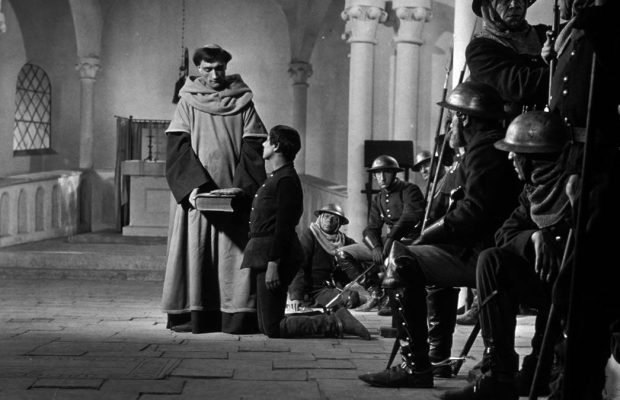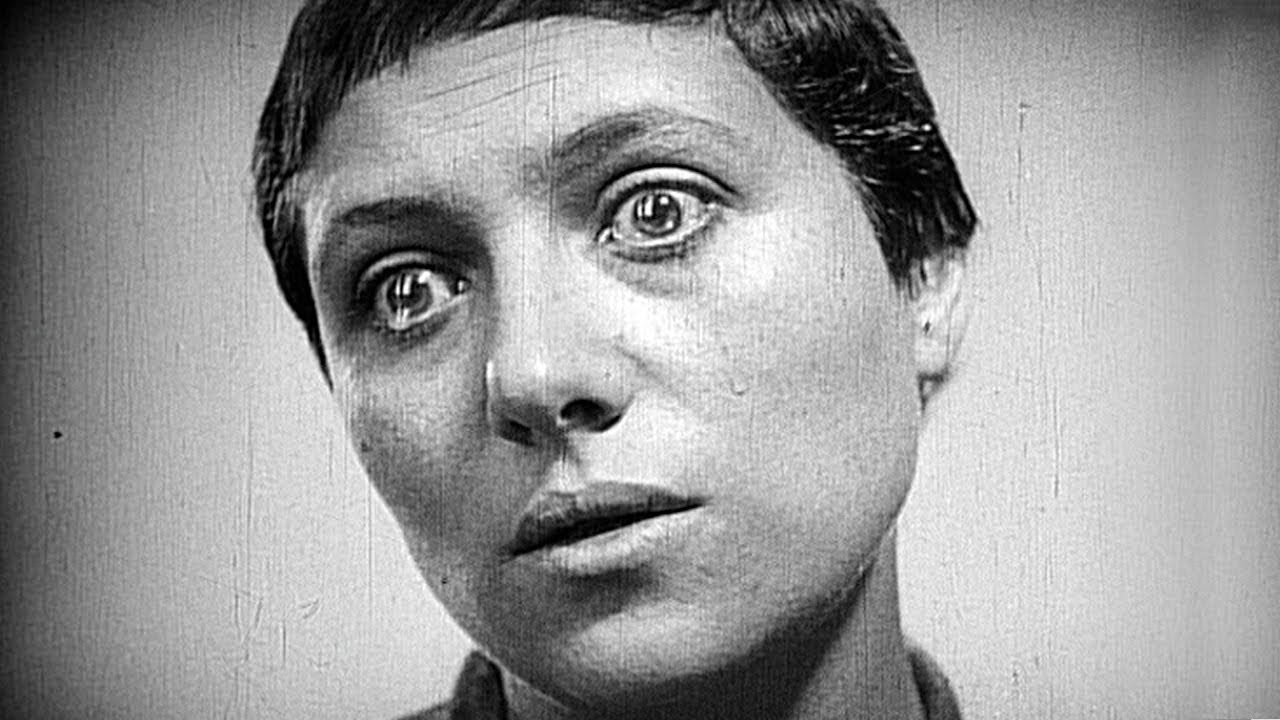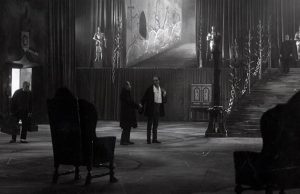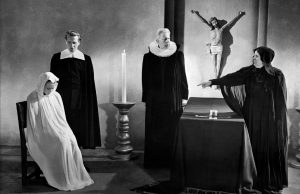The Passion of Joan of Arc (1928)

Toronto Film Society presented The Passion of Joan of Arc (1928) on Monday, October 30, 1950 as part of the Season 3 Main Series, Programme 2.
SECOND EXHIBITION MEETING – THIRD SEASON
Monday, October 30, 1950 8.15 p.m.
Royal Ontario Museum Theatre
NOTE: Late-comers will be admitted during the first film because of its length; they are asked to take front seats in order not to disturb members who are seated.
LOBBY FILM from 7.45 to 8.10 p.m. – Champlain – 1 reel silent shadowgraph by M.C. Morrison of Vancouver. Canadian history is enacted in silhouette by children in the fourth and fifth grades.
______________________________________________________________________
GOD SAVE THE KING
The Great Glassblower (Le Grand Verrier) France, 1933 French commentary Source: M.M.A. Length 20 minutes
DIRECTION: Jean Benoit-Levy
MUSIC: Jean Wiener
Jean Benoit-Levy, known for La Maternelle and La Mort Due Cygne, emphasized in the camera study of Marinot, the master glassblower the elements of aesthetic craftsmanship involved in the extremely difficult task of creating objects of art in glass. Shots of the robust artist with his few seemingly crude and simple instruments appear in startling contract to delicate scenes in nature which inspire the fragile and brittle works.
ANNOUNCEMENTS
The Passion of Joan of Arc (France, 1928) English titles Source: M.M.A. Length at 18 frames 2 hours
At Land (U.S.A. 1944) Source: Canadian Film Institute Length 14 minutes
The fame of the Danish director, Carl-Theodor Dreyer rests on three films: Passion of Joan of Arc (1928), Vampyr (1931) and Day of Wrath (1944). During thirty years of film production Dreyer has not been a busy director, for the high artistic quality of his pictures has frightened away the commercial producers. For years, after Joan, he had to make a living by writing reports on court proceedings for a Copenhagen daily, and to obtain the chance to make Day of Wrath was a major operation performed by a group of influential and stubborn friends. After that, silence again descended on Dreyer. Lately he has been making documentaries for the Danish Government, and very recently he visited the United States to find financial backing for a film he has long wanted to make–a film on the life of Christ to be made in Israel and Hollywood.
Dreyer writes his own scripts and does his own cutting. In all his films his aim is to express the inner tension of strong emotional conflict. He is not working to please a remote or specialized public: he feels that the truth of human feeling should appeal to all audiences.
The Passion of Joan of Arc (1928)
PRODUCTION: Société Generale de Films
DIRECTION: Carl-Theodor Dreyer
SCENARIO: Carl-Theodor Dreyer and Joseph Deltiel
PHOTOGRAPHY: Rudolph Maté and Kotula
ART DIRECTION: Jean Victor-Hugo and Herman Wann
HISTORICAL ADVICE: Pierre Champion
CAST: Mlle. Falconetti (Joan), O. Silvain (Bishop Cauchon), Maurice Schutz (Loyseleur), Ravet (Jean Beaupere), André (Berley (Jean d’Estivet), Antonin Artrand (Massieu).

In Dreyer’s unique study of Joan of Arc he was concerned solely with the analysis of the last agonized hours of a girl tortured by the organized power of religious orthodoxy. Recently asked in an interview if he bore a grudge against the Catholic Church, Dreyer replied, “I don’t want to criticise the Catholic Church. I want to criticise the whole social structure of its time, of which the Church is just a part. This goes for Joan as well as for Day of Wrath. It is the cruelty and stupidity of the whole society which I want to show.”
Dreyer’s method was to concentrate upon a technique of narrative through close-shot. We see only the faces, the tears, the woolen stuffs, leather, steel, stone, sky–in a monumental close-ups, separated by dialogue titles. Dreyer was working at the time on the border of the silent and sound film, and this work was an attempt to stretch the silen film to the limits of expression.
Mlle. Falconetti’s performance is considered one of the greatest given by an actress on the screen. She had had no previous film experience.
A synchronized musical score from phonograph recordings will accompany the film.
At Land (1944)
CONCEIVED AND DIRECTED by Maya Deren in 1944
TECHNICAL ASSISTANCE by Hella Heyman and Alexander Hammid
THE CENTRAL FIGURE played by Maya Deren
NOTE: This film is being screened at the end of the meeting for the benefit of the members who did not see it in the Society’s first Season. It will not be included in the programme of films to be presented by Miss Deren at the Joint Discussion Group Nov. 6.
In At Land the movements of one individual constitute the unifying device, not plot, external narration or character portrayal. It has no dialogue or music or sound effects. Of the theme, Miss Deren says: “It is the effort of the individual to relate himself to a fluid, apparently incoherent, universe.”
Maya Daran is concerned above all with film as a creative, independent art form, quite distinct from the entertainment, documentary and educational functions which film has a measure fulfilled. She has attempted to create experiences on film out of the very nature of the film instrument–that is–its temporal and spacial resources.
ANNOUNCEMENTS
A LECTURE-DEMONSTRATION BY MAYA DEREN will be presented at the first Joint Discussion Group Meeting on Monday, November 6th at 8.15 p.m. in the Women’s Union Theatre, 79 St. George St. (University Campus). The following films will be shown and discussed:-
A Study in Choreography for Camera
Ritual in Transfigured Time
Meditation on Violence
(1945) 3 minutes
(1945-46) 16 minutes
(1948) __ minutes
Members are asked to register in the lobby tonight if they plan to attend.
THE AMAZING STORY OF 16MM SOUND MOTION PICTURES, an advertising booklet is being distributed to members. The Society is fortunate in having been able to obtain copies of this excellent exposition. Members not receiving theirs in the mail may pick them up at the back of the theatre.
NEXT EXHIBITION MEETING: NOV. 13: Human Growth, Night Mail, Le Tonnelier
The print of Tabu was scheduled has been damaged: a modern feature is being negotiated for as a substitute.










Despite the objections and cutting of the film by clerical and government authorities, it was a major critical success when first released and has consistently been considered one of the greatest films ever made since 1928. It has been praised and referenced by many film directors and musicians. After having led the French in numerous battles against the English during the Hundred Years’ War, Joan of Arc is captured near Compiegne and eventually brought to Rouen to stand trial for heresy by French clergymen loyal to the English.